About STA Vehicle Inspection
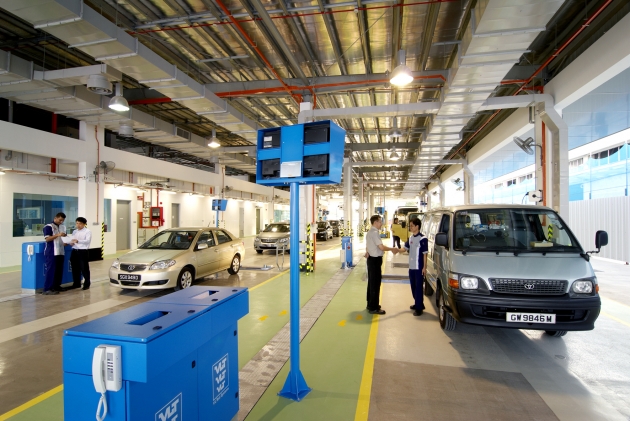 A car’s life cycle in Singapore can be likened to that of a person – we both need a continuous supply of fuel (petrol and food respectively) to keep going. And like human beings, cars need to go for regular check-ups in order to remain safe on the roads.
A car’s life cycle in Singapore can be likened to that of a person – we both need a continuous supply of fuel (petrol and food respectively) to keep going. And like human beings, cars need to go for regular check-ups in order to remain safe on the roads.
With vehicles due for inspection every one to two years, it always pays to visit a trusted vehicle inspection centre to keep your vehicle in tip-top condition. I had the privilege to go to the STA Inspection Centre at Jalan Boon Lay recently to get a glimpse of how a vehicle inspection process is like at Singapore’s leading vehicle inspection centre.
The Vehicle Inspection Process
With large signages placed at strategic locations, it’s easy to locate the inspection centre. As I entered, I noticed there were three lanes in operation. Mr Chua, the centre’s supervisior, pointed out that each lane is designated for different vehicle types.
The first is for buses and heavy goods vehicles, the second is for taxis and light goods vehicles while the last is for cars and petrol vehicles. At peak periods, the second lane can double up as an inspection lane for cars and heavy goods vehicles.
Depending on the type of vehicle, the inspection process is split into 3 or 4 stages. Drivers can leave their vehicle at the start of the designated inspection lane while an inspection officer takes over the vehicle and drives it through the lane for inspection. With the driver then free to make payment, everybody’s time is optimised.
Stage 1: Car Identity Checks
The inspection process begins with a security check to ensure that the vehicle’s chassis number (registration number), and other particulars are in line with LTA’s system records. All it takes is a quick scan of the In-Vehicle Unit (IU) for all the details to show up on the computer screen in STA’s system.
There is a computer screen at every inspection station, each tagged with a RFID card reader. The inspector responsible for checks at each respective station scans his staff pass for security purposes. I was heartened to note that there is accountability at every stage of the inspection process.
Stage 2: Vehicular Body Checks
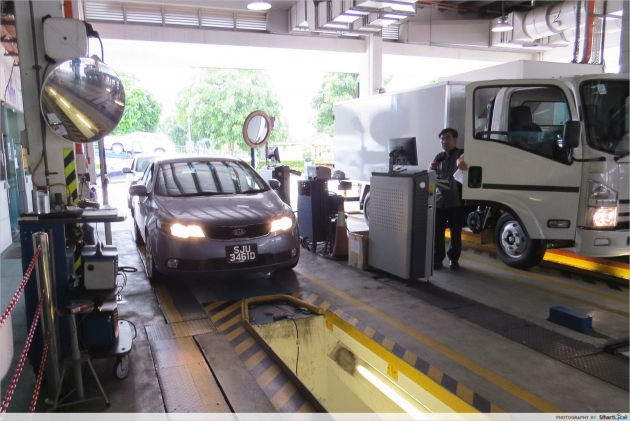 Once the first stage of checks are completed, the car is driven over an inspection pit for the second stage of the process. Here, visual checks are conducted for both the car’s under and above carriage.
Once the first stage of checks are completed, the car is driven over an inspection pit for the second stage of the process. Here, visual checks are conducted for both the car’s under and above carriage.
The inspector looks out for illegal forms of vehicle modifications. Special attention was given to general items like seatbelts and horns, as well as lighting equipment such as direction indicators, front, rear and stop lamps. The car’s windscreen and windows are also checked also checked to ensure light transmission fulfill inspection guidelines.
At the same time, a probe is inserted into the exhaust pipe to measure the levels of exhaust emissions of petrol-driven vehicles.
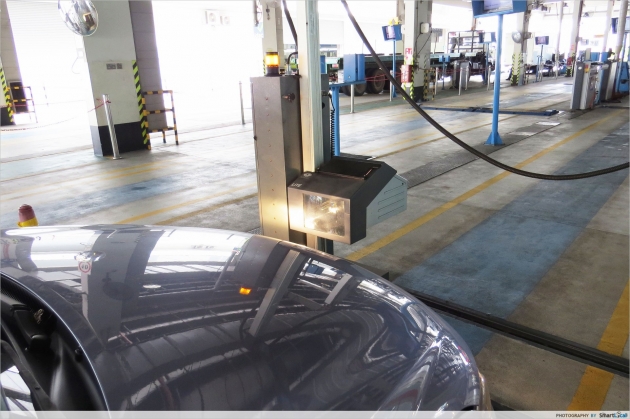 Meanwhile, the car is given a headlight and sound level test by two machines. A lighted machine pans across the headlamps to measure their luminous intensity as well as their horizontal and vertical aim when the high beam is switched on.
Meanwhile, the car is given a headlight and sound level test by two machines. A lighted machine pans across the headlamps to measure their luminous intensity as well as their horizontal and vertical aim when the high beam is switched on.
The sound test helps determine the vehicle’s noise level when the engine is revved – this process helps keep unnecessarily loud cars off the roads.
The facilities in STA are more high-tech than what we usually see on television. The inspectors here don’t lie on a rolling board and slide under the car to inspect it – the inspection pit under the car is at least 2 metres deep, and inspectors can stand in them to inspect the car’s undercarriage.
I managed to tag along to see how a car’s undercarriage looks from under a car, giving me a better understanding of the STA inspectors’ jobs.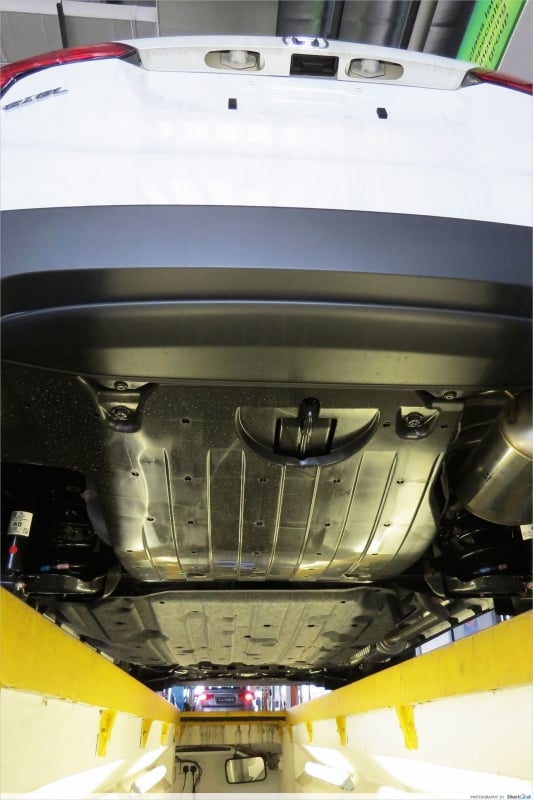
Stage 3: Wheel Alignment and Brake Tests
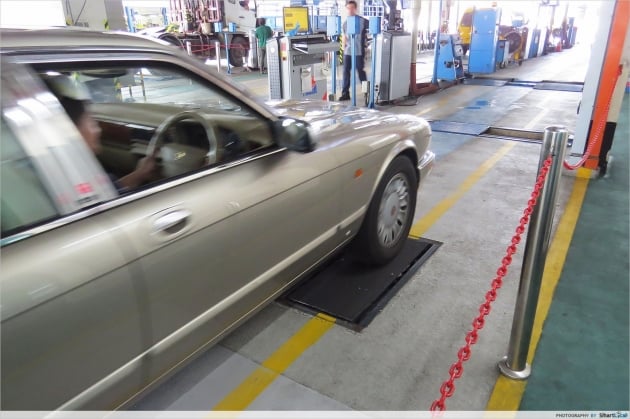 With all that done, the car is off to the third stage! Following instructions on a computerised screen, the inspector drives the car over a sensor plate for the wheel alignment test, which ensures that the wheels don’t slip to the side when moving forward.
With all that done, the car is off to the third stage! Following instructions on a computerised screen, the inspector drives the car over a sensor plate for the wheel alignment test, which ensures that the wheels don’t slip to the side when moving forward.
After that, the car will proceed to the brake test station to inspect the brake efficiency of both the front and rear axles of the vehicle.
Stage 4: Chassis Dynamometer Smoke Test
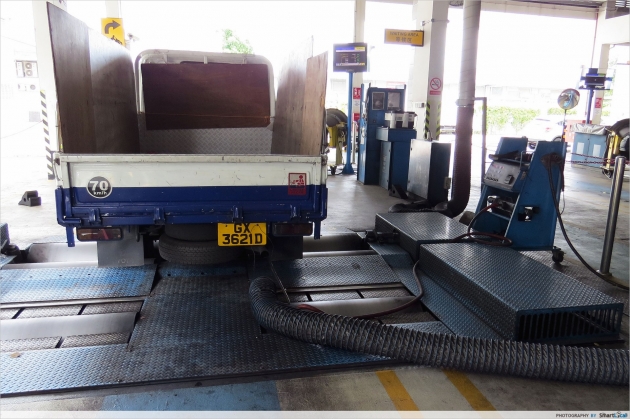 If you’re the owner of a petrol-driven vehicle, the inspection process for your vehicle is done. However, vehicles powered by diesel are required by law to undergo a Chassis Dynamometer Smoke Test (CDST). The test examines the amount of black smoke emitted from the vehicle’s exhaust pipe to ensure that they are within the limits stipulated by NEA.
If you’re the owner of a petrol-driven vehicle, the inspection process for your vehicle is done. However, vehicles powered by diesel are required by law to undergo a Chassis Dynamometer Smoke Test (CDST). The test examines the amount of black smoke emitted from the vehicle’s exhaust pipe to ensure that they are within the limits stipulated by NEA.
STA also provides a taximeter test to ensure that your taxi fares correspond to the distance travelled.
The inspection process takes 10 minutes for cars, 12 minutes for diesel-powered vehicles due to the CDST, and 14 minutes for taxis. Motorcycles also undergo the same inspection process but it takes only 6 to 8 minutes.
With that, everything is completed! An test certificate will be presented for vehicles that pass the test. And while you’re at the centre, you can conveniently pay your road tax at STA’s road tax counter.
The inspection centre also has an Independent Damage Assessment Centre (IDAC) in case your vehicle meets with an accident on the road. STA also provides car rental services in the event your damaged vehicle needs a couple more days for recovery.
If you’re too busy to bring your car down for an inspection, don’t worry as STA extends its inspection hours to 9pm on weekdays so you can head down after work.
What I learnt from STA
While I’ve done my fair share of driving, it’s my dad who takes the car on its routine inspections. Prior to this experience, my knowledge on vehicle inspection was close to zero. There was so much to learn from Mr Chua, who was eager to share his years of knowledge. He also explained things to me which I would otherwise take eons to understand.
As consumers, we have to send our vehicles for inspection on time. Behind the scenes, it’s these vehicle inspectors who work to keep our cars safe and our roads hazard-free.
While vehicle inspection centres islandwide follow a standard procedure, I was glad to see that STA adds a personal touch to its services – the all-in-one service centre is a godsend to the many time-strapped vehicle owners in Singapore, while office workers will rejoice at the extended weekday operating hours. It’s also nice to see how thoughtful the people at STA are, going the extra mile to make things easier for its customers.
If your vehicle is due for inspection, do note STA is holding a slew of promotions to reward its customers. From now till 13 December, receive a prize for every vehicle inspected at STA. Join their Facebook contest and stand to win $20 Shell petrol vouchers or snag a weekly mystery prize for yourself.
Besides vehicle inspection, STA also offers a comprehensive range of services for the convenience of all motorists. For more information, please visit www.stai.com.sg. You can also head over to STA Inspection’s Facebook page here.
Getting to STA Inspection
Address: 249 Jalan Boon Lay, Singapore 619523
Opening hours: Mon-Fri: 8am to 9pm | Sat: 8am to 5pm | Closed on Sundays and Public Holidays
Alternatively, visit their other outlet at:
Address: 302 Sin Ming Road, Singapore 575627
Opening hours: Mon-Fri: 8am to 9pm | Sat: 8am to 5pm | Closed on Sundays and Public Holidays
This post was brought to you by STA Inspection.




